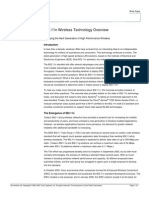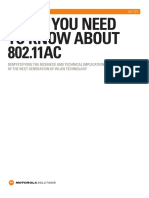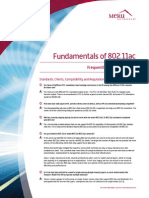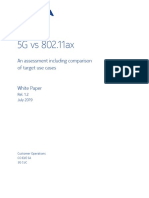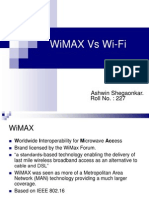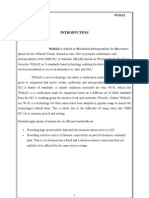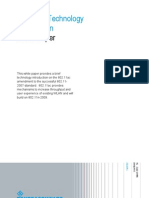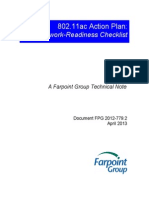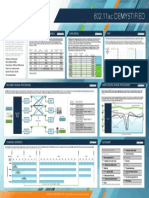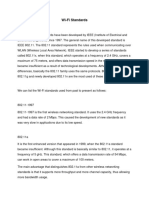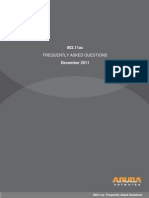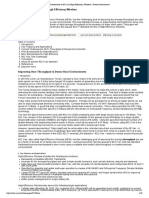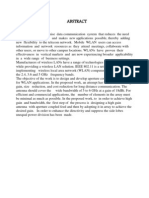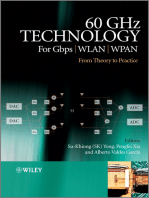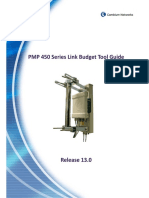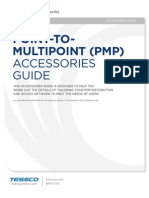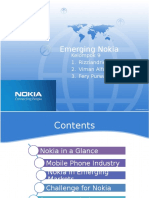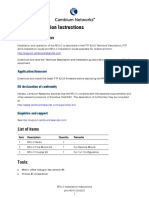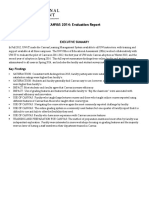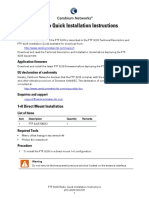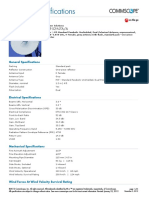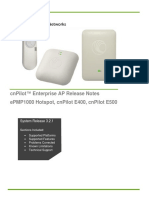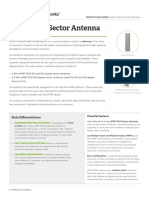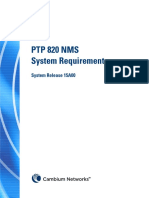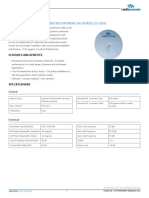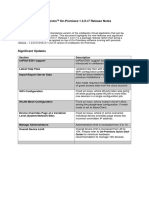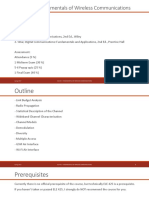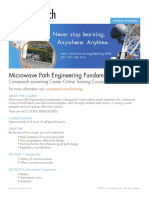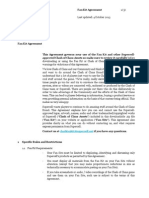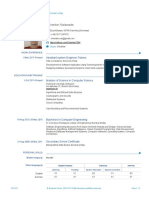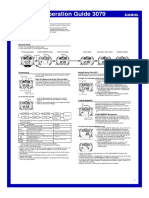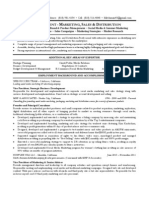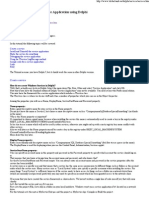802.11ac Overview: Why Is 802.11ac Needed?
802.11ac Overview: Why Is 802.11ac Needed?
Uploaded by
javierdb2012Copyright:
Available Formats
802.11ac Overview: Why Is 802.11ac Needed?
802.11ac Overview: Why Is 802.11ac Needed?
Uploaded by
javierdb2012Original Title
Copyright
Available Formats
Share this document
Did you find this document useful?
Is this content inappropriate?
Copyright:
Available Formats
802.11ac Overview: Why Is 802.11ac Needed?
802.11ac Overview: Why Is 802.11ac Needed?
Uploaded by
javierdb2012Copyright:
Available Formats
802.
11ac Overview
A new IEEE standard is in the wings ready to make its debut on the wireless market stage: 802.11ac. 802.11ac builds upon the success of 802.11n which is now the predominant WLAN standard in the market. 802.11n brought improvements in data rates and link efficiencies; however, consumer and commercial trends have created demand for a new set of capabilities which are addressed by 802.11ac (see Table 1). Table 1 - 802.11ac Major Features Enhancements 802.11ac Features Wider channels Higher encoding density Increased number of spatial streams Beamforming Multi-user MIMO Customer Benefits Higher data rates up to 1.3Gbps per radio Higher bit density per packet Higher data rates per AP/client link Greater wireless AP/client link reliability Greater AP/client capacity and efficient use of spectrum
The cumulative benefit of 802.11ac features will enable Wi-Fi solutions to meet todays demand for high capacity and high quality mobile real-time applications like video and voice.
Why is 802.11ac needed?
As the commercial population becomes more mobile, two trends have emerged for Wi-Fi solutions to address: 1. Mobile applications now demand more bandwidth Video and voice applications have increased the demand for pervasive bandwidtheverywhere. 2. Individuals carry multiple wireless devices With an average corporate mobile device/user ratio approaching 2.7 (laptop, tablet, and/or smartphone), client congestion has become a problem for wireless networks. The challenge for 802.11ac is to meet todays functional demands and the explosive wireless market growth that is expected over the next three to five years.
802.11ac explained
The 802.11ac standard addresses these new business requirements to achieve the goal of higher data rate and greater link reliability by sophisticated RF architectural enhancements that include: Wider channel support 802.11ac mandates support of 80MHz wide channels with optional 160MHz wide channels to achieve higher data rates than are achieved with 802.11n. Table 2 - 802.11ac Data Rates by Channel Width Channel Width # Spatial Streams 1 20 MHz 86 Mbps 40 MHz 200 Mbps 80 MHz 433 Mbps 160 MHz 866 Mbps
2 3 4
173 Mbps 288.9 Mbps 346.7 Mbps
400 Mbps 600 Mbps 800 Mbps
866 Mbps 1.3 Gbps
1.73 Gbps 2.34 Gbps
1.73 Gbps 3.46 Gbps
Achieving higher data rates, however, comes at a cost: fewer available channels in the 5 GHz band. With 802.11a, there are a total of 24 non-overlapping channels available, but with 802.11ac, achieving the maximum data rate possible reduces that number to two for 80MHz and only one for 160 MHz wide channels. Table 3 - Available 802.11ac Channels Including DFS* Channel size 40 MHz 80 MHz 160 MHz US 8 4 1 EUROPE 9 5 2 Excluding DFS US 4 2 -EUROPE 2 1 ---
* DFS = Dynamic Frequency Selection for avoiding interference with Weather Radar Achieving maximum data rates with 802.11ac can be an insurmountable coverage challenge for traditional Wi-Fi vendors (see Table 3) for whom it is imperative to have at least three nonoverlapping channels for adequate pervasive coverage. Merus technology is built with a single channel architecture and can maximize the performance and coverage of a 802.11ac-class solution, making Meru the de facto vendor able to deploy facility-wide solutions. The other optimizations in 802.11ac also include: Denser amplitude modulation 256-QAM - four times denser than 802.11n further increasing the bit rate density achieved by 802.11ac. More spatial streams - up to eight spatial streams, further increasing the data rate for each radio. (Note that first-generation silicon will support only three spatial streams.) Beamforming to fortify RF connections increases reliability of the AP/client link. Multi-user MIMO supports simultaneous transmissions to multiple clients and maximizes RF band utilization. Up to four distinct clients can receive data simultaneously from a single AP at full channel data rate.
Timetable for commercial availability of 802.11ac
Industry availability of commercial products will precede the ratification of the standard. The IEEE task group projects no functional changes to the specification, so Wi-Fi vendors are proceeding with plans to release products in mid-2013 (see below).
Because the 802.11ac standard has modified the RF physical and MAC layer specification, deployment of an 802.11ac-based network will require the purchase of new access points. The availability of 802.11ac, however, does not make 802.11n products obsolete because there remains a strong requirement for supporting 2.4GHz mobile devices. Enterprise deployments of 802.11ac will have to consider support for 2.4GHz.
802.11ac deployment strategies
Purchase and integration of 802.11ac will involve three decision points: 1. When to buy. 802.11n meets about 80-90% of the bandwidth demand of todays mobile applications. In most cases, the on-boarding of applications like tele-presence and voice will trigger the decision to buy 802.11ac. 2. Once a buy decision has been made, the next decision must be how to deploy 802.11ac to best provide for continued support of 2.4GHz devices. An 802.11ac deployment might mean a forklift replacement of older 802.11n equipment with dual-radio/dual-mode 802.11ac products or it might mean deploying an 802.11ac-only solution as an overlay to an existing 802.11n network. Either way, there will be a CAPEX factor to address. 3. A decision must then be made on how pervasive is the need for Very High Throughput (VHT). One strategy would involve deploying VHT hotspots only where localized higher data rates or client density is required. Merus single channel architecture greatly simplifies this decision to extend VHT support pervasively throughout a facility.
Why Meru?
Meru technology is designed to maximize the benefit of 802.11ac Merus single-channel architecture is not limited by reduced channel availability in order to maximize wireless RF coverage. Meru can further maximize RF resources through channel layering compounding RF resource availability.
Traditional Wi-Fi deployments were designed with availability of three or more channels and required site surveys for each installation or upgrade. In such cases, 802.11ac deployments may
only support a concept of islands of VHT, limiting high data rate access to certain fixed locations within a facility. Meru, on the other hand, is designed to exploit limited channel availability - even in the case of a single 160MHz channel because of our single channel architecture.
802.11ac is on the horizon and the new standard is focused on: Extending the usability of a wireless LAN to a broader set of high-data rate applications. Supporting higher client density. Contributing to increased productivity and lower network TCO.
Because of Merus unique single-channel architecture, an investment in a Meru 802.11ac solution allows you to remain mobile and have continuous access to VHT throughout a facility. Meru is leading the charge to deliver a robust 802.11ac offering. Our goal is to provide the most advanced Wi-Fi network solution in the market, so that your organization can reap the full benefits of 802.11ac and thrive.
Meru 802.11ac Investment Protection Plan
Designed to protect wireless infrastructure investments as the 802.11 wireless standard moves to the next 802.11 standard, the innovative Investment Protection Plan allows Meru customers to access robust wireless solutions today, without compromising their ability to take advantage of technology advances delivered by the 802.11ac standard. To simplify a future transition to 802.11ac, customers purchasing Merus AP332s, AP320s or AP433s access points between November 1, 2012 and June 28, 2013, will have an option to pay an additional $499 per access point and trade them in for qualifying Meru 802.11ac access points when they become available.
You might also like
- EuPlatesc DocumentatieDocument7 pagesEuPlatesc DocumentatieciumonkNo ratings yet
- IGW500 Series Internet Gateway Web Configuration Manual (V1.1-20220223)Document223 pagesIGW500 Series Internet Gateway Web Configuration Manual (V1.1-20220223)jorgegonzalesNo ratings yet
- Indoor Radio Planning: A Practical Guide for 2G, 3G and 4GFrom EverandIndoor Radio Planning: A Practical Guide for 2G, 3G and 4GRating: 5 out of 5 stars5/5 (1)
- 802.11n Wireless Technology Overview: Deploying The Next Generation of High Performance WirelessDocument7 pages802.11n Wireless Technology Overview: Deploying The Next Generation of High Performance WirelessswalayNo ratings yet
- White Paper: 802.11ac Survey: Gigabit Wifi Has ArrivedDocument9 pagesWhite Paper: 802.11ac Survey: Gigabit Wifi Has ArrivedAndyNo ratings yet
- Wi-Fi Technology Note WF104: Migrating To 802.11n While Supporting Legacy 802.11b/g ApplicationsDocument6 pagesWi-Fi Technology Note WF104: Migrating To 802.11n While Supporting Legacy 802.11b/g Applicationsgamer08No ratings yet
- Migrating To 802.11n While Supporting Legacy 802.11b, G Applications (2006)Document6 pagesMigrating To 802.11n While Supporting Legacy 802.11b, G Applications (2006)Chiti ChoopayakNo ratings yet
- 802.11n: Next-Generation Wireless LAN Technology: White PaperDocument13 pages802.11n: Next-Generation Wireless LAN Technology: White PaperALEXANDRE JOSE FIGUEIREDO LOUREIRONo ratings yet
- 802.11n: Next-Generation Wireless LAN Technology: White PaperDocument13 pages802.11n: Next-Generation Wireless LAN Technology: White PapermanjunathbhattNo ratings yet
- 802.11ac: The Fifth Generation of Wi-Fi: Technical White PaperDocument25 pages802.11ac: The Fifth Generation of Wi-Fi: Technical White PaperSubash ShresthaNo ratings yet
- Motoroal - 802.11ac White PaperDocument10 pagesMotoroal - 802.11ac White PaperL1architectNo ratings yet
- WP Netgear 802 11ac WifiDocument5 pagesWP Netgear 802 11ac WifivladotrkuljaNo ratings yet
- 2012 Faq 802.11ac Standards Clients Compatibility RegulationsDocument0 pages2012 Faq 802.11ac Standards Clients Compatibility Regulationsjavierdb2012No ratings yet
- WiMAX: Final Destination or PathDocument7 pagesWiMAX: Final Destination or Pathharjitsingh198No ratings yet
- WP-802.11nPrimer OKDocument15 pagesWP-802.11nPrimer OKNoha AminNo ratings yet
- 5G Vs WiFi 6Document14 pages5G Vs WiFi 6Bala JE/BSNLNo ratings yet
- Networking PPT On WiMAX Vs WiFiDocument21 pagesNetworking PPT On WiMAX Vs WiFiKarthik AvinashNo ratings yet
- Ieee 802.16 and Wimax: Broadband Wireless Access For EveryoneDocument8 pagesIeee 802.16 and Wimax: Broadband Wireless Access For Everyonechaidar_lakareNo ratings yet
- Cisco's Unified Wireless Solutions: Aduait Pokhriyal ID - No. 34915Document34 pagesCisco's Unified Wireless Solutions: Aduait Pokhriyal ID - No. 34915Aduait PokhriyalNo ratings yet
- Groundwork For New Level Wireless Access WP-107113Document15 pagesGroundwork For New Level Wireless Access WP-107113embsbrNo ratings yet
- 802.11 Overview PDFDocument8 pages802.11 Overview PDFSandeep PandeyNo ratings yet
- Terms and Mnemonics: Download atDocument8 pagesTerms and Mnemonics: Download atNaveed NazirNo ratings yet
- What Is Wimax?: Standards Associated To WimaxDocument20 pagesWhat Is Wimax?: Standards Associated To WimaxSujith KallingalNo ratings yet
- 802.11ac The Fifth PDFDocument20 pages802.11ac The Fifth PDFjamal abkiNo ratings yet
- 802 11acDocument16 pages802 11acTanmay SahuNo ratings yet
- Term Paper Synopsis - 1Document6 pagesTerm Paper Synopsis - 1psdNo ratings yet
- WiFi Standards 802.11a B G N vs. 802.11acDocument3 pagesWiFi Standards 802.11a B G N vs. 802.11acDavid SofitaNo ratings yet
- ST Paul'S University Nairobi CampusDocument8 pagesST Paul'S University Nairobi CampusQui BuiNo ratings yet
- Wi-Max Communication System - by Salman HasanDocument44 pagesWi-Max Communication System - by Salman Hasanapi-19781188100% (1)
- "Wimax": Emerging Wireless TechnologyDocument12 pages"Wimax": Emerging Wireless Technologyapi-20008301No ratings yet
- Wimax Is Defined As Worldwide Interoperability For Microwave Access by The Wimax Forum, Formed in June 2001 To Promote Conformance andDocument13 pagesWimax Is Defined As Worldwide Interoperability For Microwave Access by The Wimax Forum, Formed in June 2001 To Promote Conformance andSoorej KamalNo ratings yet
- 802 11acDocument29 pages802 11acHarshaNo ratings yet
- 802.11ac Action Plan:: A Network-Readiness ChecklistDocument9 pages802.11ac Action Plan:: A Network-Readiness Checklista_sahaiNo ratings yet
- 802.11ac: The Fifth Generation of Wi-Fi: Technical White PaperDocument20 pages802.11ac: The Fifth Generation of Wi-Fi: Technical White PaperchopanalvarezNo ratings yet
- 4 43136 AST0130372 80211ac PosterpdfDocument1 page4 43136 AST0130372 80211ac PosterpdfmasimnaseerNo ratings yet
- 802.11 StandardDocument3 pages802.11 StandardDaljit SinghNo ratings yet
- Wireless 60GHz ResearchDocument5 pagesWireless 60GHz ResearchStephen ShankoNo ratings yet
- What Is 802.11acDocument5 pagesWhat Is 802.11acahmed sheikhNo ratings yet
- Ap 7532 Data SheetDocument7 pagesAp 7532 Data SheetStephenNo ratings yet
- 3.1 Wi-Fi StandardsDocument5 pages3.1 Wi-Fi Standardsamit_post2000No ratings yet
- How To Cable 802.11n Wireless Access Points: White PaperDocument5 pagesHow To Cable 802.11n Wireless Access Points: White Paperabul abbasNo ratings yet
- Mobile Computing Assignment: Submitted by Sakaanaa M 2017115583Document31 pagesMobile Computing Assignment: Submitted by Sakaanaa M 2017115583Sakaanaa MohanNo ratings yet
- 802.11 WlanDocument27 pages802.11 WlanAparnaSkpNo ratings yet
- Frequently Asked QuestionsDocument8 pagesFrequently Asked QuestionsgesperNo ratings yet
- 2.4Ghz - Use For Internet Access OnlyDocument9 pages2.4Ghz - Use For Internet Access OnlyShirish RansingNo ratings yet
- Wimax and The Concept of ImplementationDocument29 pagesWimax and The Concept of ImplementationRajanMiglani396No ratings yet
- IEEE 802.11ahDocument5 pagesIEEE 802.11ahteste_downloadNo ratings yet
- WNS Mwan Ap 7181 FaqDocument3 pagesWNS Mwan Ap 7181 FaqAdvantec SrlNo ratings yet
- 802 11axDocument10 pages802 11axtien nguyenNo ratings yet
- NI Intro To 802.11axDocument10 pagesNI Intro To 802.11axDaniel WongNo ratings yet
- Throughput Enhancement With Fragment Retransmission For Very High-Speed WlansDocument2 pagesThroughput Enhancement With Fragment Retransmission For Very High-Speed WlansNishanth KalakuntlaNo ratings yet
- 802.11 - Wi-Fi Standards and Speeds Explained - Network World PDFDocument6 pages802.11 - Wi-Fi Standards and Speeds Explained - Network World PDFTecnologia MasterNo ratings yet
- Understanding Technology Options For Deploying Wi-Fi White PaperDocument43 pagesUnderstanding Technology Options For Deploying Wi-Fi White Paperophyx007No ratings yet
- Wimax Benefits Applications & Solutions: Key Challenges: Key Challenges: Key Challenges: Key ChallengesDocument7 pagesWimax Benefits Applications & Solutions: Key Challenges: Key Challenges: Key Challenges: Key ChallengesJohn C. YoungNo ratings yet
- Wimax e vs. D White PaperDocument7 pagesWimax e vs. D White PaperLino VargasNo ratings yet
- Wi-Fi Best PracticesDocument7 pagesWi-Fi Best Practiceshotsync101No ratings yet
- AbstractDocument1 pageAbstractmanisha_shakya_4No ratings yet
- Abstract:-T: Microwave Access by The Wimax Forum, Formed in June 2001 ToDocument10 pagesAbstract:-T: Microwave Access by The Wimax Forum, Formed in June 2001 ToManohar Reddy MNo ratings yet
- Microsoft Word - IEEE 802.11ax QShineDocument6 pagesMicrosoft Word - IEEE 802.11ax QShinealewNo ratings yet
- Reconfigurable Radio Systems: Network Architectures and StandardsFrom EverandReconfigurable Radio Systems: Network Architectures and StandardsNo ratings yet
- 60GHz Technology for Gbps WLAN and WPAN: From Theory to PracticeFrom Everand60GHz Technology for Gbps WLAN and WPAN: From Theory to PracticeNo ratings yet
- CWNA Certified Wireless Network Administrator Study Guide: Exam CWNA-108From EverandCWNA Certified Wireless Network Administrator Study Guide: Exam CWNA-108No ratings yet
- PMP450 Link Budget and Network Planner v1Document25 pagesPMP450 Link Budget and Network Planner v1javierdb2012No ratings yet
- Accessorize Your Cambium Point-To-multipoint SystembDocument10 pagesAccessorize Your Cambium Point-To-multipoint SystembJorge Valencia CordobaNo ratings yet
- GSM Linkbudget OriginalDocument2 pagesGSM Linkbudget Originaljavierdb2012No ratings yet
- 1000 Reflector Dish: Main DifferentiatorsDocument2 pages1000 Reflector Dish: Main Differentiatorsjavierdb2012No ratings yet
- Module 3 - PMP450 - Installation v1 - 1Document25 pagesModule 3 - PMP450 - Installation v1 - 1javierdb2012No ratings yet
- Emerging Nokia: Kelompok 9 1. Rizziandrie Zairul 2. Viman Alfarizi R 3. Fery PurwaginanjarDocument19 pagesEmerging Nokia: Kelompok 9 1. Rizziandrie Zairul 2. Viman Alfarizi R 3. Fery Purwaginanjarjavierdb2012No ratings yet
- Cambium PTP 820 FIPS 140-2 Security Policy: PTP 820C PTP 820S PTP 820N PTP 820A PTP 820G PTP 820GXDocument35 pagesCambium PTP 820 FIPS 140-2 Security Policy: PTP 820C PTP 820S PTP 820N PTP 820A PTP 820G PTP 820GXjavierdb2012No ratings yet
- Dimensioning Tool v02 PDFDocument35 pagesDimensioning Tool v02 PDFjavierdb2012No ratings yet
- HD Series™ High Performance Dish Antenna: Hdda5WDocument2 pagesHD Series™ High Performance Dish Antenna: Hdda5Wjavierdb2012No ratings yet
- Cambium PTP 820S Series Technical DescriptionDocument208 pagesCambium PTP 820S Series Technical Descriptionjavierdb2012No ratings yet
- Zerto Technology Comparison 2015Document4 pagesZerto Technology Comparison 2015javierdb2012No ratings yet
- RFU-C Installation InstructionsDocument3 pagesRFU-C Installation Instructionsjavierdb2012No ratings yet
- Canvas 2014 Final Draft1Document48 pagesCanvas 2014 Final Draft1javierdb2012No ratings yet
- CMM5 Quick Start GuideDocument2 pagesCMM5 Quick Start Guidejavierdb2012No ratings yet
- PTP 820S Radio Quick InstallDocument6 pagesPTP 820S Radio Quick Installjavierdb2012No ratings yet
- 1.2 M - 4 FT Standard Performance Parabolic Reflector Antenna, Dual-Polarized, 5.25-5.85GhzDocument3 pages1.2 M - 4 FT Standard Performance Parabolic Reflector Antenna, Dual-Polarized, 5.25-5.85Ghzjavierdb2012No ratings yet
- PMP Synchronization Guide 007v001 01092017Document172 pagesPMP Synchronization Guide 007v001 01092017javierdb2012No ratings yet
- Product Specifications Product Specifications: Px4F PX4F - 52 52 - N7A/A N7A/ADocument5 pagesProduct Specifications Product Specifications: Px4F PX4F - 52 52 - N7A/A N7A/Ajavierdb2012No ratings yet
- CnPilot E400E500 Indoor and EPMP 1000 Hotspot Release Notes 3.2.1Document7 pagesCnPilot E400E500 Indoor and EPMP 1000 Hotspot Release Notes 3.2.1javierdb2012No ratings yet
- E PMP 1000 Sector AntennaDocument7 pagesE PMP 1000 Sector Antennajavierdb2012No ratings yet
- Wideband Channel Characterization: Spring 2017 Ele 492 - Fundamentals of Wireless CommunicationsDocument25 pagesWideband Channel Characterization: Spring 2017 Ele 492 - Fundamentals of Wireless Communicationsjavierdb2012No ratings yet
- PTP820 NMS - System Rquirement - R15A00Document9 pagesPTP820 NMS - System Rquirement - R15A00javierdb2012No ratings yet
- 0.9 M - 3 FT Standard Performance Parabolic Reflector Antenna, Dual-Polarized, 5.25-5.85GhzDocument3 pages0.9 M - 3 FT Standard Performance Parabolic Reflector Antenna, Dual-Polarized, 5.25-5.85Ghzjavierdb2012No ratings yet
- CnMaestro On-Premises Release Notes 1.3.0-r7Document4 pagesCnMaestro On-Premises Release Notes 1.3.0-r7javierdb2012No ratings yet
- LinkBudgetAnalysisDocument46 pagesLinkBudgetAnalysisjavierdb2012No ratings yet
- EPMP 1000 Threshold and SNRDocument1 pageEPMP 1000 Threshold and SNRjavierdb2012No ratings yet
- Microwave Path Engineering Fundamentals SyllabusDocument2 pagesMicrowave Path Engineering Fundamentals Syllabusjavierdb2012No ratings yet
- School MagicaDocument40 pagesSchool MagicaAshish SikarwarNo ratings yet
- Cjis White Paper 2Document7 pagesCjis White Paper 2David BriggsNo ratings yet
- iVMS-4200 Client Software: Key FeatureDocument9 pagesiVMS-4200 Client Software: Key FeatureFrancisco MoreiraNo ratings yet
- Cyber Laws in PakistanDocument28 pagesCyber Laws in PakistanAiny MughalNo ratings yet
- Porn Law Video TechnologyDocument180 pagesPorn Law Video TechnologyMaria Do Carmo PereiraNo ratings yet
- Bronx Rug CleanerDocument27 pagesBronx Rug Cleanercleningh8No ratings yet
- TRISTAR Complete Promo Codes - XLSX - TRISTAR - PROMO CODES 2024Document10 pagesTRISTAR Complete Promo Codes - XLSX - TRISTAR - PROMO CODES 2024Fake DraculaNo ratings yet
- U1 l10 The 8 Most Famous People in TechnologyDocument9 pagesU1 l10 The 8 Most Famous People in TechnologyFritz Ren KeifferNo ratings yet
- CN Questions and AnswersDocument9 pagesCN Questions and AnswersShenbaga VengatNo ratings yet
- Lindab Magicad Plugin For Dimcomfort, Dimsilencer and LindqstDocument13 pagesLindab Magicad Plugin For Dimcomfort, Dimsilencer and Lindqstu_florinNo ratings yet
- SDWAN (Software Defined-WAN) Technology Evaluation and ImplementationDocument17 pagesSDWAN (Software Defined-WAN) Technology Evaluation and ImplementationWasayefNo ratings yet
- Courier Protocol: For K-Bus, IEC870 and General ImplementationsDocument45 pagesCourier Protocol: For K-Bus, IEC870 and General ImplementationsJessada SatwinitNo ratings yet
- SG 246219Document458 pagesSG 246219api-3707774No ratings yet
- Annales Dissertation em LyonDocument7 pagesAnnales Dissertation em LyonIDon'TWantToWriteMyPaperCanada100% (1)
- Supercell Fan Kit Agreement 20131004Document3 pagesSupercell Fan Kit Agreement 20131004api-238152931No ratings yet
- Verifone Integration Package 37Document413 pagesVerifone Integration Package 37Jonny JacksonNo ratings yet
- WimaxDocument19 pagesWimaxMrityunjay SinghNo ratings yet
- RBS 3000 Commissioning ProcedureDocument26 pagesRBS 3000 Commissioning ProcedureEhtesham KhanNo ratings yet
- To Understand The Song of BirdsDocument4 pagesTo Understand The Song of BirdsDavid LeónNo ratings yet
- Chirantar Nalawade CVDocument3 pagesChirantar Nalawade CVChirantarNalawadeNo ratings yet
- AWS Certified Solutions Architect Professional BlueprintDocument3 pagesAWS Certified Solutions Architect Professional BlueprintSrikanth VarmaNo ratings yet
- 2G SMS FlowDocument37 pages2G SMS FlowShaharyar Khan100% (2)
- 3G Congestion OptimizationDocument4 pages3G Congestion Optimizationmuh47irNo ratings yet
- Operation Guide 3079: About This ManualDocument4 pagesOperation Guide 3079: About This Manuallefteris82No ratings yet
- Vice President Marketing in Los Angeles CA Resume Mitch PerlissDocument2 pagesVice President Marketing in Los Angeles CA Resume Mitch PerlissMitchPerlissNo ratings yet
- Online Hotel ManagementDocument29 pagesOnline Hotel ManagementSunil YadavNo ratings yet
- Service Application TutorialDocument10 pagesService Application Tutorialpippo1microsoftNo ratings yet
- IRRI Annual Report 2002-2003Document103 pagesIRRI Annual Report 2002-2003CPS_IRRI100% (1)



